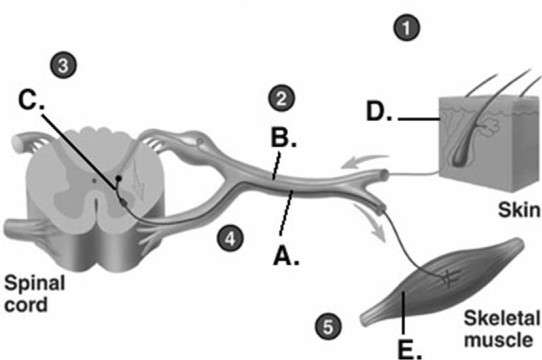A) muscle spindle reflex
B) Golgi tendon reflex
C) gamma motor reflex
D) withdrawal reflex
E) alpha motor neuron reflex
G) A) and B)
Correct Answer

verified
Correct Answer
verified
Multiple Choice
Which of the following nerves is part of the brachial plexus?
A) peroneal
B) ansa cervicalis
C) ischiadic (sciatic)
D) musculocutaneous
E) femoral
G) A) and D)
Correct Answer

verified
Correct Answer
verified
Multiple Choice
What is found the lateral gray horns of the spinal cord?
A) The cell bodies of somatic motor neurons.
B) The cell bodies of sensory neurons.
C) The cell bodies of autonomic motor neurons.
D) The cell bodies of somatic sensory neurons.
F) All of the above
Correct Answer

verified
Correct Answer
verified
Multiple Choice
Match the nerve to the correct function. -ulnar nerve
A) provides motor innervation to the biceps brachii
B) innervates two forearm muscles plus most of the intrinsic hand muscles
C) innervates all but one of the flexor muscles of the forearm and most of the hand muscles near the thumb
D) innervates the deltoid and teres minor muscles
E) innervates the triceps brachii
G) A) and B)
Correct Answer

verified
Correct Answer
verified
Multiple Choice
There are _____ enlargements of the spinal cord where nerves supplying the extremities enter and leave.
A) two
B) three
C) four
D) five
E) six
G) C) and E)
Correct Answer

verified
Correct Answer
verified
Multiple Choice
The spinal cord
A) controls the reticular activating system.
B) stores reflexive memory.
C) forms memory engrams.
D) links the peripheral nervous system to the brain.
E) is characterized by conscious activity.
G) A) and B)
Correct Answer

verified
Correct Answer
verified
Multiple Choice
What structure anchors the thecal sac and conus medullaris to the coccyx?
A) filum terminale
B) denticulate ligaments
C) pia mater
D) cauda equina
F) A) and B)
Correct Answer

verified
Correct Answer
verified
Multiple Choice
Stretch reflexes
A) are learned voluntary responses.
B) aid in maintaining proper posture.
C) prevent muscles from being damaged by excessive tension.
D) cause the removal of limbs from painful stimuli.
E) prevent falling.
G) B) and C)
Correct Answer

verified
Correct Answer
verified
Multiple Choice
The adaptive significance of the crossed extensor reflex when a person steps on a tack is to
A) remove the foot from the tack.
B) increase the rate at which withdrawal of the limb occurs.
C) slow the rate of removal of the foot from the tack.
D) reduce the pain sensations.
E) prevent the person from falling down.
G) A) and D)
Correct Answer

verified
Correct Answer
verified
Multiple Choice
Match the term with the most appropriate description. -a reflex that helps prevent falls
A) stretch reflex
B) Golgi tendon reflex
C) withdrawal reflex
D) crossed extensor reflex
E) reciprocal innervation
G) A) and B)
Correct Answer

verified
Correct Answer
verified
Multiple Choice
Which nerve is involved when a dancer points his/her toes?
A) tibial
B) femoral
C) obturator
D) pudendal
E) common fibular (peroneal)
G) C) and E)
Correct Answer

verified
Correct Answer
verified
Multiple Choice
Match the disorder with its description. -meningitis
A) pain radiating down the back of the thigh and leg
B) stiffness in the neck and headache
C) inflammation of a nerve
D) pain along a nerve tract
E) loss of sensation
G) C) and E)
Correct Answer

verified
Correct Answer
verified
Multiple Choice
 -Label component "A" on the reflex arc.
-Label component "A" on the reflex arc.
A) sensory receptor
B) effector organ
C) sensory neuron
D) motor neuron
E) interneuron
G) C) and D)
Correct Answer

verified
Correct Answer
verified
Multiple Choice
What space,found between the vertebral wall and the dura mater,is the area for injecting anesthesia for childbirth?
A) subarachnoid space
B) subdural space
C) epidural space
D) epipial space
F) A) and D)
Correct Answer

verified
Correct Answer
verified
Multiple Choice
Damage to the phrenic nerve would result in
A) the loss of motor activity in the arms.
B) an increased heart rate.
C) an inability to swallow.
D) difficulty breathing.
E) a decreased heart rate.
G) C) and E)
Correct Answer

verified
Correct Answer
verified
Multiple Choice
Which of the following statements concerning the structure of spinal nerves is true?
A) The ventral root contains motor or efferent fibers.
B) The ventral root has a prominent root ganglion.
C) Rootlets from the surface of the spinal cord form the dorsal and ventral rami.
D) Each spinal nerve is formed by the union of a cranial nerve and a spinal nerve.
E) Spinal nerves do not have specific cutaneous distributions.
G) B) and C)
Correct Answer

verified
Correct Answer
verified
Multiple Choice
There are ________ cervical spinal nerves.
A) eight
B) twelve
C) six
D) five
E) fourteen
G) B) and C)
Correct Answer

verified
Correct Answer
verified
Multiple Choice
The branch of a spinal nerve that innervates deep muscles on the dorsal thorax is the
A) ramus communicans.
B) lateral ramus.
C) dorsal ramus.
D) ventral ramus.
E) medial ramus.
G) A) and E)
Correct Answer

verified
Correct Answer
verified
Multiple Choice
Which of the following nerves is associated with the lumbosacral plexus?
A) phrenic
B) median
C) musculocutaneous
D) ulnar
E) obturator
G) D) and E)
Correct Answer

verified
Correct Answer
verified
Multiple Choice
The spinal cord ends at the
A) sacrum.
B) coccyx.
C) 5th lumbar vertebrae.
D) 2nd lumbar vertebrae.
F) A) and B)
Correct Answer

verified
Correct Answer
verified
Showing 61 - 80 of 124
Related Exams